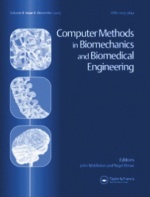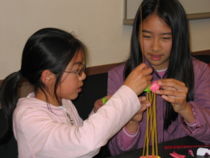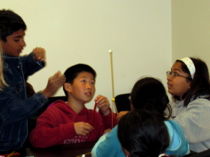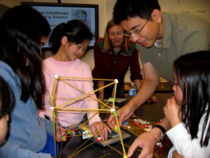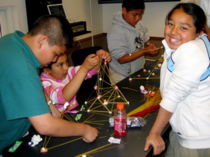(→welcome the new equipment in the cool lab) |
(→welcome the new equipment in the cool lab) |
||
| Line 1: | Line 1: | ||
| − | ==welcome the new equipment in the cool lab== | + | ==welcome the new equipment in the cool lab!== |
<html> | <html> | ||
Revision as of 23:02, 17 February 2012
welcome the new equipment in the cool lab!

| 
| 
| 
|

| 
| 
| 
|

| 
| 
| 
|

| 
| 
| 
|

| 
| 
| 
|
computer models in biomechanics: from nano to macro
iutam symposium on computer models in biomechanics
08/29/11-09/02/11, stanford university, california
ellen kuhl,
gerhard holzapfel

abstract the computational modeling of biomechanics and mechanobiology is one of the most exciting, and, at the same time, one of the most challenging problems of mechanics in the 21st century. mechanical modeling and computational simulations in biology hold promise to provide new insight into complex multiscale and multiphysics phenomena of living tissue: the quantitative analysis of biomechanical processes on the molecular, cellular, tissue, and organ levels might enable reliable predictions of the progression of various types of disease. this may allow us, within the next decade or two, to perform real time, patient specific simulations to guide the design of optimal treatment strategies. to live up to these tremendous expectations, research in computational biomechanics must be highly multidisciplinary. the goal of this iutam symposium is therefore to bring together leading experts in cell mechanics, continuum mechanics, computational mechanics, bioengineering, and regenerative medicine to encourage critical discussion and identify important trends and directions in computational biomechanics.
kuhl lab @amse summer bioengineering conference
06/22/11-06/25/11 asme summer bioengineering conference,
farmington, pennsylvania

manu, ellen, alex, the eagle, tyler, corey
kuhl lab @serdar goodbye party #42

wolf, dominique, anna, john, madeleine, manu, ellen, serdar, oscar, alkis, uwe, anton, kitsch, poornima
the mathematics of growth & remodeling of soft biological tissues
miniworkshop
mathematisches forschungsinstitut oberwolfach
08/31/08-09/06/08, oberwolfach, germany, report (download)
ellen kuhl,
davide ambrosi,
krishna garikipati

back
antonio di carlo,
isaac vikram chenchiah,
anders klarbring,
ellen kuhl,
krishna garikipati,
andreas menzel,
harish narayanan,
paolo podio-giudugli,
angela stevens,
patrick shipman,
martine ben amar.
italian front
guido vitale,
davide ambrosi,
alfio grillo,
luigi preziosi.
abstract biology is becoming the most attractive field of application of mathematics. the discoveries that have characterized the biological sciences in the last decades have become the most fertile matter for application of classical mathematical methods, while they offer a natural environment where new theoretical questions arise. mathematical biology' has born many years ago and has developped along directions that now constitute its traditional background: population dynamics and reaction-diffusion equations. nowadays mathematical biology is differentiating into several branches, essentially depending on the specific spatial scale size under consideration: molecular scale (i.e. dna transcription, protein folding and cascades), cellular scale (i.e. motility, aggregation and moprhogenesis) and macroscale (i.e. tissue mechanics). currently one of the most attractive scientific topics is the mathematics of growth and remodelling of soft biological tissues. this area, located at the crossroads of biology, mathematics and continuum mechanics, concerns the statement and analysis of the equations that characterize the mechanics, growth and remodelling of systems like arteries, tumors and ligaments, studied at the macroscopic scale. these are open continuous systems that pose new challenging questions, which go beyond the standard mechanics that is traditionally devoted to closed systems. past initiatives in oberwolfach have been devoted to the interaction between biology and mathematics in a broad sense. a minisymposium in oberwolfach focusing on the mathematics of growth and remodelling of soft biological tissues' would be the occasion to bring together established researchers on this topic with newer entrants to the field.
cardiovascular tissue engineering
group retreat
cardiovascular tissue engineering
07/11/08-07/13/08, asilomar

back
gadryn higgs, serdar goktepe, chris zarins, joe wu, beth pruitt, erin murphy, ellen kuhl, sarah heilshorn, ginel hill, ahmed assar.
font
franklin jia, joe ulerich, jonathan wong, rebecca taylor, chelsey simmons, james norman,
jin yu, cheryl wong po foo.
our goals are (i) to enhance the in vitro performance of mouse/human embryonic stem cell-derived cardiomyocytes by environmental control including: electromechanical stimulation in bioreactor systems by integrated stretchable microelectrode arrays and engineering of safe and biodegradable elastomeric scaffolds with integrated biochemical ligands and topographical cues for improved proliferation and survival of conditioned cardiomyocytes; (ii) to scale these structures from single cell layers to large area 3-d structures forming multi-cell layered tissue grafts conditioned on a pulsatile flow setup supported by numerical simulations; (iii) to perform small animal in vivo assessment using novel molecular imaging (mol-im) techniques comparing the viability of injected cells alone to engineered tissue grafts and predict their long term response based on finite element simulations; and (iv) to characterize and model effects of electromechanical conditioning on cell-cell interactions and cell-scaffold interactions.
computer simulations of mechanobiology
|
special issue on computer simulations of mechanobiology contributions by |
mechanics in biology: cells and tissue
|
theme issue on
mechanics in biology: cells and tissue contributions by |
computational mechanics of electro-active materials
minisymposium
wccm/apcom2010
07/19/10-07/23/10, sydney, australia
serdar goktepe, andreas menzel, ellen kuhl
abstract this mini-symposium aims to bring together researchers from different sub-disciplines of computational engineering sciences by providing a common discussion platform for exchanging ideas on the latest developments in the computational mechanics of electro-active materials. the phrase electro-active material refers to a broad class of materials that actively responds to an externally applied or intrinsically generated electric field by undergoing remarkable deformations. similarly, they might also generate an electric activity when subjected to mechanical loading. electro-active materials are not restricted to man-made products such as piezoelectrics, ferroelectrics, dielectric polymers but also cover a wide range of bio-materials such as cardiac tissue or skeletal muscle. synthetically produced electro-active materials have a wide spectrum of applications such as high-tech devices, bio-medical products, or artificial muscles. the optimal design and successful manufacture of these synthetic materials invariably necessitate accompanying quantitative computational analyses of the products that commonly possess complex geometries. the computational modeling of electro-active biological tissue, on the other hand, plays a key role in guiding patient-specific therapies such as surgical operations, novel stem cell-based treatments of infarcted cardiac tissue when the experimental techniques fall short. advances in computational modeling of these seemingly distinct classes of materials can, of course, mutually and positively influence each other towards the development of artificial organs and design of bio-inspired functionally-optimized high-tech devices.
active tissue modeling - from single muscle cells to muscular contraction
minisymposium
10th usnccm
07/16/07-07/19/07, columbus, ohio, usa
markus bol,
ellen kuhl
abstract all living creatures share a common architectural feature: the cell. this functional unit is the root of all life. muscle cells can be found in smooth muscles which are concerned with the movements of internal organs as well as in skeletal muscles which contribute to the locomotion of creatures. cells undergo and control a lot of intra- and extracellular events with distinct mechanical characteristics to perform various functions. however, there are a lot of questions concerning the mechanical characteristics of muscle cells and the biological connection between the cells at the micro level and the muscles at the macro level. the aim of this mini-symposium is to bridge the gap between cell mechanics and the modelling of locomotor/movement systems as well as contraction processes in general. it is well-known that today’s computational tools are indispensable to augment experimental techniques for a deeper under¬standing of soft tissues like skeletal or smooth muscles. computational biomechanics may increase success rates of clinical interventions and therapeutic effectiveness which is also of great socio-economical interest. active biological tissues are characterised by a huge spectrum of very complex properties such as anisotropy, damage, growth and their ability to undergo large deformations. many of these aspects are not captured sufficiently in material models and computational methods. to advance the aforementioned it is necessary to bring together in this minisymposium scientists and bioengineers in the areas of computational mechanics and especially experimental techniques and procedures.
multiscale modeling of materials
minisymposium
9th usnccm
07/23/07-07/26/07, san francisco, usa
ellen kuhl,
ekkehard ramm
abstract multiscale modeling of materials has advanced to a research topic of growing interested in the past decades. This trend is driven by the desire to characterize the material behavior, in particular in the context of material failure, as accurately as possible by looking at the characteristic substructure of the material on smaller scales. a typical example are granular media which can be described through phenomenological continuum theories on the macroscopic level while discrete particle interaction theories provide further insight in their complex failure phenomena on the microscopic level. bridging the gap between the different scales is one of the most challenging problems in multiscale modeling. from a computational point of view, this task can be accomplished in two different ways: the individual scales can either be coupled horizontally or vertically. In the former approach, which could be thought of as a kind of model adaptivity, the material characterization is refined in regions of particular interest, e.g. in potential failure zones, while the remaining part of the structure is still modeled on the phenomenological level. the vertical coupling approach is maybe more common in material modeling. while continuum-based strategies like the finite element method can be applied to simulate the material behavior on the macroscopic scale, discrete element techniques, particle methods or dislocation dynamics are typically applied to characterize the material response on the microscopic scale. the vertical coupling thus essentially aims at defining appropriate analytical or numerical homogenization techniques to carry discrete microscopic information up to the macroscopic phenomenological level. within this mini-symposium, we encourage abstracts related to the following key issues: micromechanically motivated constitutive models, higher order continuum theories, discrete element simulations of different failure phenomena, enhanced finite element techniques to simulate overall structural failure, multifield aspects of material failure, model adaptivity, computational homogenization techniques, and experimental validation and parameter identification.
computational methods in biological growth and remodeling
minisymposium
9th usnccm
07/23/07-07/26/07, san francisco, usa
ellen kuhl,
krishna garikipati
abstract this symposium will focus on theoretical and computational methods for mass and volumetric change (growth) and microstructural changes (remodeling) in biomechanical problems. over the past two decades, a number of theoretical approaches have been laid down to explain functional adaptation of biological tissues. Included among them are the classical theory of adaptive elasticity, open system thermodynamics, reaction diffusion in porous media, mixture theories and different theories of microstructural evolution. within this minisymposium, we would like to turn the focus somewhat to the challenges related to the computational realization of these theories, while still recognizing the need for continued theoretical development. with these aims in mind, we invite abstracts addressing (but not necessarily restricted to) the following topics of relevance to biological growth and remodeling: further development of growth and remodeling theories, algorithms for multifield phenomena of mechanics, transport and reaction, appropriate formulation and time discretization of biological rate equations, computational treatment of scale interaction in space and time, the role of computational homogenization techniques, and relaxation methods in microstructural evolution.
spaghetti towers @stanford
some impressions of stanford's class of 2020 during stanford's society of women engineers' exploring new worlds spaghetti tower building contest,
more pics spaghetti towers 01, spaghetti towers 02
| justine & lindy - the highest but heaviest |
|---|
|
with a height of 3.8 spaghetti lengths, justine and lindy built one of the highest towers! it's foundation is totally laffy taffy and beautiful! due to its colorful but massive candy basement, the building was not only the highest but with 112g also the heaviest construction of the day. congrats to justine and lindy for this beautiful high tower! |
| edward, hanson, abhishek & sean - the real engineering one |
|---|
|
our favorite engineers of the day! edward, hanson, abhishek & sean really worked together as a team and created this cool 1.4 story building. due to its truss structure (and because you guys ate the laffy taffys rather then build them in) this 47g structure is super light! guys, you should definitely become engineers! |
| karishma, abi, aaron & brijen - the highest |
|---|
|
the most slender and elegant structure was designed by karishma, abi, aaron & brijen. with only 44g it was superlight and yet 3.6 spaghetti lengths high. it needed a little human support but its triangular foundation was totally solid and stable! congratulations to this team for its really great engineering design! |
| megan, vina, anna, claire - the nonsymmetric one |
|---|
|
who said that girls can't build towers??? this girls only team added an extra challenge by making their truss structure nonsymmetric. it was 1.4 spaghettis lengths high and one of the most beautiful buildings of the day! weighing was a challenge though due to its width! congrats to this great team! |
| the most stable one |
|---|
|
this one's really great! super engineered and 2.4 spaghetti lengths high and yet extremely light! definitely one of our favorite architectural designs! congratulations to this super cool tensegrity structure! buckminster fuller would love it! |
conferences & travel
09/03/12-09/07/12 modeling and simulation in soft tissue biomechanics, graz, austria
07/09/12-07/21/12 from nonlinear physics to biology and medicine, corsica, france
07/09/12-07/13/12 european solid mechanics conference, graz, austria
07/02/12-07/05/12 efficient solvers in biomedical application, graz, austria
06/20/12-06/23/12 asme summer bioengineering conference, fajardo, puerto rico
03/26/12-03/30/12 gamm 2012, darmstadt, germany
02/13/12-02/14/12 multiscale methods and validation in medicine and biology, san francisco, california
08/29/11-09/02/11 iutam symposium on computer models in biomechanics, stanford, california
07/25/11-07/29/11 11th usnccm,
minneapolis, minnesota
06/22/11-06/25/11 asme summer bioengineering conference,
farmington, pennsylvania
04/18/11-04/21/11 gamm 2011,
graz, austria
10/06/10-10/09/10 bmes 2010,
austin, texas
09/26/10-10/01/10 birm mathematical foundation of mechanical biology,
banff, canada
07/19/10-07/23/10 wccm/apcom2010,
sydney, australia
06/27/10-07/02/10 16th usnctam,
state college, pennsylvania
06/23/10-06/25/10 modern trends in geomechanics II,
stanford, california
03/22/10-03/26/10 gamm 2010,
karlsruhe, germany
01/27/10-01/28/10 modeling biological materials,
college station, texas
10/06/09-10/13/09 erlangen, germany
09/02/09-09/04/09 complas x,
barcelona, spain
07/16/09-07/19/09 10th usnccm,
columbus, ohio
06/17/09-06/21/09 asme summer bioengineering conference, lake tahoe, california
08/31/08-09/06/08 mathematics of growth & remodeling,
miniworkshop, oberwolfach, germany
08/24/08-08/30/08 ictam 2008,
adelaide, australia
06/25/08-06/29/08 asme summer bioengineering conference,
marco island, florida
06/18/08-06/21/08 iutam symposium biomechanics,
woods hole, massachusetts
03/02/08-03/05/08 orthopaedic research society,
54th annual meeting, san francisco, california
09/20/07-09/21/07 growth in the desert,
workshop, tucson, arizona
07/23/07-07/26/07 9th usnccm,
san francisco, california
07/16/07-07/20/07 iciam 07,
zurich, switzerland
07/02/07-07/05/07 instabilities across the scales,
delft, the netherlands
06/20/07-06/24/07 asme summer bioengineering conference,
keystone, colorado
